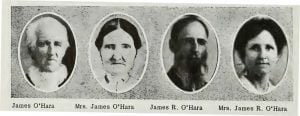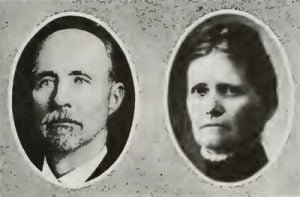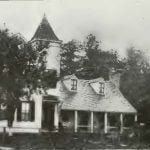Henry O’Hara and his family, consisting of his wife, Margaret Brown O’Hara, and ten children, left Fredrick County, Maryland, in the latter part of 1811 and moved to Nelson County, Kentucky. His children, born in order here named, were: Mary, Amellia, Catherine, James, Thomas, Samuel, Henry, Sarah, John, and Charles. The family lived on a farm in Kentucky for six years, and in the fall of 1817 set out by wagons for the State Illinois. Arriving in Illinois, they lived during the winter of 1817 in the Mississippi bottom, south of Cahokia, and in the spring of 1818 moved on a farm four miles below Prairie du Rocher, along the bluff, where they resided until 1819, then moved six miles north to claim No. 1284, survey No. 611, and from that time the place was known as the O’Hara Settlement. When Henry O’Hara left Kentucky he bought, in Beardstown, the works of their clock, and when he was established in his home, O’Hara Settlement, he had the case built at Kaskaskia and the clock works placed in it.
After the death of Henry O’Hara, Sr., which occurred in June, 1826, the clock became the property of his eldest son, James O’Hara. James O’Hara continued to reside on the homestead until his death, which occurred April 8, 1884, he being 84 years and 5 months old.
By will of James O’Hara, his youngest son Charles became the owner of the clock. This clock has, during all the years from the time it was first put in operation up to the present time, been a true and reliable timekeeper and has not been remodeled or rebuilt.
By will of Charles O’Hara, his eldest son Henry became the owner of the clock.
James O’Hara
James R. O’Hara, the retired merchant, was born July 29, 1841, on the old homestead, near Ruma, Illinois. After receiving his education in the parochial and public schools he attended the Christian Brothers College in St. Louis. After leaving school he worked on the farm for his father until 1867, when he bought a farm in Monroe County. In 1872 he sold his farm and went to Ruma and erected the store property; one year later he entered the general merchandise business. Later he again bought a farm of 120 acres near Ruma. In 1916 he retired from the merchandise business, and rented his farm. He has learned the valuable lesson in life – to be contented.
His father, James O’Hara, was born in Maryland and came to Ruma in 1818, just a little prior to admitting Illinois into the union. He was one of the pioneers of Southern Illinois. He died in 1884.

James R. O’Hara married, November 27, 1874, Miss Margaret Kaveny, and the present family numbers four children – one son, Chas. A. O’Hara; three daughters, Mary Elizabeth, Kathrine E. and Rose M. O’Hara.
Mr. O’Hara is a Democrat, and served the community as postmaster for twelve years and as notary public for eight years.
Mrs. O’Hara (nee Kaveny) was born February 11, 1858, in St. Louis, Missouri. Her parents moved to Litchfield, Illinois. At the age of 17 years she came to Ruma, Illinois, to teach the first parochial school, and taught here from 1875 to 1877, when she was married.
Charles O’Hara

Charles O’Hara was born October 24, 1849. He lived here all his life, with the exception of five years, when he lived in St. Louis. He was one of the best known and highly respected men of Randolph County. His death occurred January 23, 1915.
He was married to Miss Ellen Carter of Hecker, Illinois, on October 7, 1878. To this union were born eight children, two dying while quite young. The six surviving children are three sons and three daughters, as follows: Henry T., Lucy, James P., Stella J., William L. and Isabell O’Hara. He also leaves his two brothers and two sisters.
His wife died January 9, 1908, and since then he made his home on the home place and in St. Louis.



